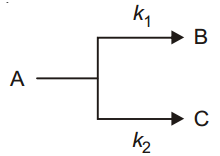
Parallel or Side Reactions
 المؤلف:
Arun Bahl, B.S. Bahl and G.D.Tuli
المؤلف:
Arun Bahl, B.S. Bahl and G.D.Tuli
 المصدر:
Essential Physical Chemistry
المصدر:
Essential Physical Chemistry
 الجزء والصفحة:
p 761
الجزء والصفحة:
p 761
 30-9-2018
30-9-2018
 1043
1043
Parallel or Side Reactions
In these reactions the reacting substance follows two or more paths to give two or more products. The preferential rate of such may be changed by varying the conditions like pressure, temperature or catalyst. The reaction in which the maximum yield of the products is obtained is called the main or major reaction while the other reaction (or reactions) are called side or parallel reactions. For example,

In the above reaction the reactant A gives two products B and C separately in two different reactions with rate constants k1 and k2 respectively.
If k1 > k2 the reaction A ⎯→B will be the major reaction and A ⎯→C will be the side or parallel reaction. Let us assume that both these reactions are of first order and concentration of A is [A] at the time t. The differential rate expressions are

where k′ is the first order rate constant. It is equal to the sum of the two constants k1 and k2 of two side reactions.
Integrating equation (iii), we get

where [A]0 is the initial concentration of the reactant A and [A]t is concentration of A at time t.
The ratio of the rates of two side reactions is obtained by dividing equations (i) by (ii), we have

From equations (iv) and (v) we can calculate the individual rate constant k1 and k2.
 الاكثر قراءة في حركية التفاعلات الكيميائية
الاكثر قراءة في حركية التفاعلات الكيميائية
 اخر الاخبار
اخر الاخبار
اخبار العتبة العباسية المقدسة


